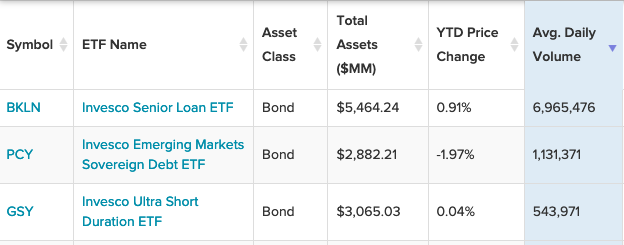Getting more than broad-based bond exposure doesn’t mean investors have to deep dive into the debt market. They can start with three ETFs from Invesco that are seeing heavy average daily volume.

Invesco Senior Loan ETF (BKLN): seeks to track the investment results of the S&P/LSTA U.S. Leveraged Loan 100 Index. The Adviser and the fund’s sub-adviser define senior loans to include loans referred to as leveraged loans, bank loans and/or floating rate loans. Banks and other lending institutions generally issue senior loans to corporations, partnerships or other entities (“borrowers”). Senior loans are typically used for business recapitalizations, acquisitions, leveraged buyouts, and re-financings. BKLN’s loan portfolio will include the purchase of loans from banks or other financial institutions through assignments or participations.
Invesco Emerging Markets Sovereign Debt ETF (PCY): PCY is based on the DBIQ Emerging Market USD Liquid Balanced Index. The Fund will normally invest at least 80% of its total assets in securities that comprise the Index (the “Index”). The Index tracks the potential returns of a theoretical portfolio of liquid emerging markets US dollar-denominated government bonds issued by more than 20 emerging-market countries. The countries in the Index are selected annually pursuant to a proprietary index methodology, and the fund as well as the index are re-balanced and reconstituted quarterly.
Invesco Ultra Short Duration ETF (GSY): seeks maximum current income, consistent with preservation of capital and daily liquidity. The fund will invest at least 80% of its net assets in fixed income securities and in ETFs and closed-end funds that invest substantially all of their assets in fixed income securities. It uses a low duration strategy to seek to outperform the ICE BofA US Treasury Bill Index in addition to providing returns in excess of those available in U.S. Treasury bills, government repurchase agreements, and money market funds, while seeking to provide preservation of capital and daily liquidity.
Why Go The ETF Route With Bonds?
ETFs have allowed access to corners of the bond market investors didn’t used to have before such as emerging markets debt. By packaging this debt in a dynamic ETF wrapper, investors not only get exposure to niche areas of the bond market, they can divest themselves of the assets quickly if they want to, helping their liquidity.
“Investors who do not adapt to use new liquidity management tools and techniques could be made worse off as the liquidity available via traditional channels declines,” wrote Jeffrey Meli, Shobhit Gupta and Zornitsa Todorova in a research note per a Bloomberg article. “ETFs themselves are so liquid that the overall transaction costs paid by investors are lower, so long as they use ETFs to manage liquidity.”
For more news and information, visit the Innovative ETFs Channel.








